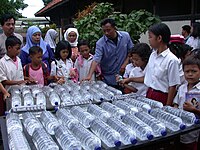
Photo from wikipedia
Heat treatment, i.e., boiling or pasteurization, is the most widely recognized and practiced form of household water treatment. Considering recent advances in the development of light harvesting nanoparticles for solar-to-heat… Click to show full abstract
Heat treatment, i.e., boiling or pasteurization, is the most widely recognized and practiced form of household water treatment. Considering recent advances in the development of light harvesting nanoparticles for solar-to-heat conversion, we envision that a nanomaterial enhanced water heating treatment system could obviate the need to use fuels or electricity to heat water by replacing the energy source with sunlight. In this study, we demonstrate that functional disinfection temperatures can be easily achieved with unconcentrated sunlight using a single layer interfacial photothermal film in direct contact with a tortuous flowing water channel. Photothermal films were fabricated by dispersing high concentrations of light harvesting nanoparticles, carbon black and Au nanorods, into a highly transparent curable polymer. Bench-scale 3-D printed reactors were employed to determine the effect of different parameters on reactor performance, such as channel height, retention time, flow rate, initial water temperature, and light intensity. Simulations demonstrate the scalability of the treatment system, predicting that a reactor footprint of 45 × 45 cm would be required for a photothermal treatment system that could produce 8 L of water per day with 8 h of sunlight at 1 Sun intensity.
Journal Title: Environmental science & technology
Year Published: 2019
Link to full text (if available)
Share on Social Media: Sign Up to like & get
recommendations!